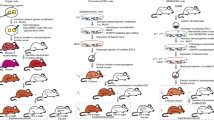Abstract
Research on genetically engineered mice provides insights into the etiology, therapy, and genetic basis of human diseases. An important variable that affects the results of mouse studies is the health status of the animals. Pathogen burdens may confound observations and obscure underlying mechanisms. Mouse resource centers frequently rederive infected mouse strains. We review our experience on the use of a well-established technique, embryo transfer to rederive infected mouse strains. The following mouse pathogens were eliminated by embryo transfer: Mouse Parvovirus, Mouse Hepatitis Virus, Mouse Rotavirus, Mouse Encephalomyelitis Virus, Mouse Adenovirus, Helicobacter species, endoparasites, and ectoparasites. We rederived transgenic mouse lines, gene-targeted mouse lines, and lines with spontaneous mutations. In the majority of strains, fertilized eggs for embryo transfer were obtained by mating superovulated egg donors with males of the desired genotype. A total of 309 embryo transfers were performed to rederive 96 mouse strains. The pregnancy rate was 76%; 1996 pups were born, of which 43% carried the desired genotype. We performed 44 additional embryo transfers to rederive 15 other strains. The pregnancy rate was lower (45%) and none of the 135 pups carried the desired genotype. Although we successfully eliminated the pathogens in all transfers, we were unable to obtain pups with the desired genotype in 15 of 111 mouse lines. Multiple factors affect the efficiency of rederivation by embryo transfer. They include the response to superovulation by embryo donors, the number and age of stud males, the yield of fertilized eggs, the number of embryo transfers, and genotyping.
Similar content being viewed by others
References
Abzug MJ and Tyson RW (2000) Protection of murine gestational tissues from picornavirus infection in the preimplantation period. Placenta 21: 422–426.
Carthew P, Wood MJ and Kirby C (1983) Elimination of Sendai (parainfluenza type 1) virus infection from mice by embryo transfer. J Reprod Fertil 69: 253–257.
Carthew P, Wood MJ and Kirby C (1985) Pathogenicity of mouse hepatitis virus for preimplantation mouse embryos. J Reprod Fertil 73: 207–213.
Colombo LL, Stazzone A, Chen GJ, Lopez MC and Watson RR (2000) Behavioral and immune changes in v-Ha-ras transgenic mice Immunopharm. Immunotox 22: 339–356.
Davis JA, Paylor R, McDonald MP, Libbey M, Ligler A, Bryant K et al. (1999) Behavioral effects of Ivermectin in mice. Lab Anim Sci 49: 288–296.
De Rijk EP, Van Rijk AF, Van Esch E, De Jong WW, Wesseling P and Bloemendal H (2000) Demyelination and axonal dystrophy in alpha A-crystallin transgenic mice. Int J Exp Path 81: 271–282.
Engle SJ, Ormsby I, Pawlowski S, Bolvin GP, Corft J, Balish E et al. (2002) Elimination of colon cancer in germ-free transforming growth factor beta 1-deficient mice. Cancer Res 62: 6362–6366.
Flecknell P (2002) Replacement, reduction and refinement. ALTEX 19:73–78.
Glass WG, Chen BP, Liu MT and Lane TE (2002) Mouse Hepatitis Virus infection of the central nervous system: Chemokine-mediated regulation of host defense and disease. Viral Immun 15: 261–272.
Hill AC and Stalley GP (1991) Mycoplasma pulmonis infection with regard to embryo freezing and hysterectomy derivation. Lab Anim Sci 41: 353–356.
Hogan B, Beddington R, Constantini F and Lacy E (1994) Manipulating the Mouse Embryo: A Laboratory Manual. Cold Spring Harbor Press, New York.
Homberger FR (1997) Enterotropic mouse hepatitis virus. Lab Animals 31: 97–115.
Homberger FR, Ilgen-Wicke B, Jacobi K, Kraft V, Kunstyr I, Mähler M et al. (1999) Implications of infectious agents on results of animal experiments. Lab Animals 33, Supplement 1: 39–87.
Jacoby RO, Ball-Goodrich LJ, Besselsen DG, McKisic MD, Riley LK and Smith AL (1996) Rodent parvovirus infection. Lab Anim Sci 46: 370–380.
Kawase Y, Iwata T, Toyoda Y and Wakayama T (2001) Comparison of intracytoplasmic sperm injection for inbred and hybrid mice. Mol Reprod Develop 60: 74–78.
Mohanty SB and Bachman PA (1974) Susceptibility of fertilized mouse eggs to minute virus of mice. Infect Immun 9: 762–763.
Morrell JM (1999) Techniques of embryo transfer and facility decontamination used to improve the health and welfare of transgenic mice. Lab Animals 33: 201–216.
National Research Council (1991) Infectious Diseases of Mice and Rats. National Academy Press, Washington, D.C., USA.
Okamoto M and Matsumoto T (1999) Production of germfree mice by embryo transfer. Exp Anim 48: 59–62.
Pyle A and Handel MA (2003) Meiosis in male PL/J mice: a genetic model for gametic aneuploidy. Mol Reprod Dev 64: 471–481.
Reetz IC, Wullenweber-Schmidt M, Kraft V and Hedrich, HJ (1988) Rederivation of inbred strains of mice by means of embryo transfer. Lab Anim Sci 38: 696–701.
Shi L, Fatemi SH, Sidwell RW and Patterson PH (2003) Maternal influenza infection causes marked behavioral and pharmacological changes in the offspring. J Neurosci 23: 297–302.
Spearow JL (1988) Major genes control hormone-induced ovulation rate in mice. J Reprod Fertil 82: 787–797.
Stringfellow DA (1998) Recommendations for the sanitary handling of in-vivo-derived embryos. In: Stringfellow DA and Seidel SM (eds), Manual of the International Embryo Transfer Society. (pp. 79–91) Savoy, IL.
Suzuki H, Yorozu K, Watanabe T, Nakura M, and Adachi J (1996) Rederivation of mice by means of in vitro fertilization and embryo transfer. Exp Anim 45: 33–38.
Thornton CE, Brown, SDM, and Glenister PH (1999) Large numbers of mice established by in vitro fertilization with cryopreserved spermatozoa: implications and applications for genetic resource banks, mutagenesis screens, and mouse backcrosses. Mamm. Genome 10: 987–992.
Tsunoda I, Iwasaki Y, Terunuma H, Sako K and Ohara Y (1996) A comparative study of acute and chronic diseases induced by two subgroups of Theiler’s murine encephalomyelitis virus. Acta Neuropath 91: 595–602.
Zeller W, Meier G, Bürki K and Panoussis B (1998) Adverse effects of tribromoethanol as used in the production of transgenic mice. Lab Animals 32: 407–413.
Author information
Authors and Affiliations
Rights and permissions
About this article
Cite this article
Van Keuren, M.L., Saunders, T.L. Rederivation of Transgenic and Gene-Targeted Mice by Embryo Transfer. Transgenic Res 13, 363–371 (2004). https://doi.org/10.1023/B:TRAG.0000040040.82536.a5
Issue Date:
DOI: https://doi.org/10.1023/B:TRAG.0000040040.82536.a5




